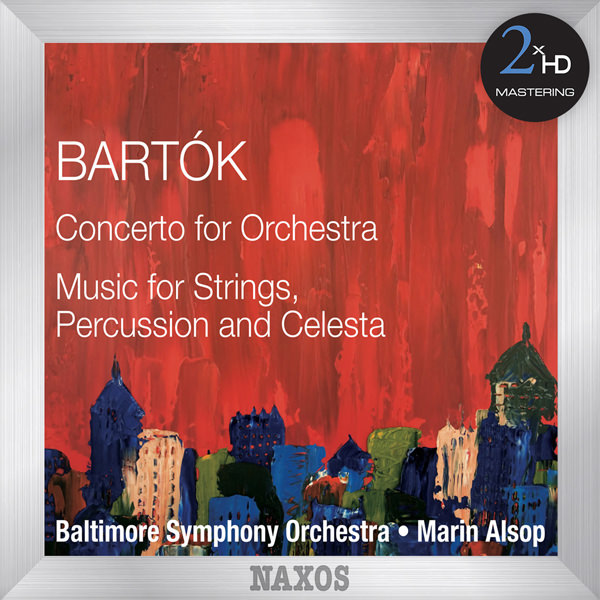
Bela Bartok – Concerto for Orchestra; Music for Strings, Percussion and Celesta – Baltimore Symphony Orchestra, Marin Alsop (2012/2015)
DSF Stereo DSD64, 1 bit/2,82 MHz | Time – 1:07:07 minutes | 2,65 GB | Genre: Classical
Studio Masters, Official Digital Download – Source: AcousticSounds | Booklet, Front Cover | © 2xHD / Naxos Right US, Inc.
Recorded: Meyerhoff Hall, Baltimore, Maryland, USA, from 2nd-4th October, 2009 (tracks 1-5), and on 3rd, 4th and 6th June, 2010 (tracks 6-9)
Béla Bartók’s Concerto for Orchestra, one of his greatest works, was written in the United States after the composer was forced to flee Hungary during World War II. It is not only a brilliant display vehicle for each instrumental section but a work of considerable structural ingenuity that unites classical forms and sonorities with the pungency of folk rhythms and harmonies. Music for Strings, Percussion and Celesta explores darker moods through a score of marvellously poised symmetry.
This release follows Marin Alsop’s ‘riveting’ (Gramophone) Baltimore Symphony recordings of Dvořák’s symphonies.
This has long been a popular coupling of works by Béla Bartók, but this new release rides on the crest of a wave of previous successes and will occupy a leading position amongst the competition on the quality of its recording and performance. Marin Alsop and the Baltimore Symphony Orchestra have a synergy which has made their Dvořák symphonic recordings sound ‘as fresh as when Dvořák put pen to paper’ (BBC Music Magazine on the Symphonies 7 and 8, NBD0010). Of Dvořák’s New World Symphony (8570714) BBC Music Magazine also wrote, ‘it is rare to be able to say that a performance forces one to listen to a work anew, but this is exactly what Alsop’s reading achieves.’
Here’s a way to tell if a performance of Bartók’s Concerto for Orchestra is likely to be an outstanding one right from the start. Listen to the sound clip below: the trumpet trio from the first movement’s introduction. Is the volume a true pianissimo? Are the players perfectly together? Is the articulation truly legato, the timbre devoid of breathiness, the tempo chosen so as to permit a real melody to emerge in just two big arcs? Do the strings accompany with crystalline calm so that the ensuing, passionate string eruption comes as a genuine shock? If all of these criteria are met, as they are here, then we’re probably in good shape for the five movements to come. Marin Alsop leads a splendid performance of this oft-recorded work, full of character, whether in the jocular “games of pairs” second movement, the ensuing spooky elegy, or the finale that begins (seemingly) a touch reserved but takes off like a shot in the coda. It’s a memorable and wholly successful effort, excellently engineered to boot. The Music for Strings, Percussion and Celesta is cut very much from the same cloth. This is one of the very few performances since Reiner’s (Solti’s LSO recording is another) that even makes an attempt to approach Bartók’s very quick indicated timings—and he specifies the length of each section down to the second (not that he really expected anyone would pay attention). This approach pays the biggest dividends in the opening fugue, which really does unfold almost visually, like an arch. It’s quite wonderful. The only drawback to this performance stems from the fact that the Baltimore strings just aren’t quite in the same league as the very greatest ensembles—say Berlin, or Leningrad under Mravinsky (but then they don’t get lost), or the best crack chamber orchestras. If only they could have dug in a little harder in the second movement, or in those scary tremolos at the climax of the nocturnal third movement, we’d have had a recording for the ages. As it is then, this is very, very good, and wholly recommendable as a pairing of these two iconic works. -David Hurwitz, ClassicsToday
Tracklist:
Béla Bartók (1881-1945)
Concerto for Orchestra, BB 123
1 I. Introduzione: Andante non troppo – Allegro vivace 9:54
2 II. Giuoco delle coppie: Allegretto scherzando 6:40
3 III. Elegia: Andante non troppo 7:32
4 IV. Intermezzo interrotto: Allegretto 4:16
5 V. Finale: Presto 9:36
Music for Strings, Percussion and Celesta, BB 114
6 I. Andante tranquillo 7:16
7 II. Allegro 7:40
8 III. Adagio 7:35
9 IV. Allegro molto 6:58
Personnel:
Baltimore Symphony Orchestra
Marin Alsop Conductor
DSF DSD64/2.82MHz
mqs.link_BartkCncertfrrchestraBaltimreSMarinAlsp20122015AcusticSundsDSD64.part1.rar
mqs.link_BartkCncertfrrchestraBaltimreSMarinAlsp20122015AcusticSundsDSD64.part2.rar
mqs.link_BartkCncertfrrchestraBaltimreSMarinAlsp20122015AcusticSundsDSD64.part3.rar



















![Marin Alsop, London Symphony Orchestra - Bernstein: Candide (2021) [FLAC 24bit/96kHz] Marin Alsop, London Symphony Orchestra - Bernstein: Candide (2021) [FLAC 24bit/96kHz]](https://imghd.xyz/images/2021/11/21/qrbexmqpj90fc_600.jpg)
![Various Artists - The Nordic Sound - 2L audiophile reference recordings (2009) [Blu-Ray Pure Audio Disc] Various Artists - The Nordic Sound - 2L audiophile reference recordings (2009) [Blu-Ray Pure Audio Disc]](https://getimg.link/images/imgimgimg/uploads/2015/12/L2WxB8c.jpg)
![Baltimore Symphony Orchestra, Marin Alsop - Symphony No. 9, ‘From the New World’ (2008/2015) [ProStudioMasters DSF DSD64/2.82MHz] Baltimore Symphony Orchestra, Marin Alsop - Symphony No. 9, ‘From the New World’ (2008/2015) [ProStudioMasters DSF DSD64/2.82MHz]](https://getimg.link/images/imgimgimg/uploads/2018/08/5b96mIs.jpg)
![Baltimore Symphony Orchestra, Marin Alsop - Dvorak: Symphonies Nos. 7 & 8 (2010/2015) [AcousticSounds DSF DSD64/2.82MHz] Baltimore Symphony Orchestra, Marin Alsop - Dvorak: Symphonies Nos. 7 & 8 (2010/2015) [AcousticSounds DSF DSD64/2.82MHz]](https://getimg.link/images/imgimgimg/uploads/2018/08/QSd2kSh.jpg)
![ORF Vienna Radio Symphony Orchestra, Marin Alsop - Voyages - Orchestral Music by James Lee III (2022) [FLAC 24bit/96kHz] ORF Vienna Radio Symphony Orchestra, Marin Alsop - Voyages - Orchestral Music by James Lee III (2022) [FLAC 24bit/96kHz]](https://i0.wp.com/imghd.xyz/images/2022/04/10/yuy2i09qhdqtb_600.jpg?resize=500%2C500&ssl=1)
![Itzhak Perlman - The Complete Warner Recordings 1972-1980 (2015) [FLAC 24bit/96kHz] Itzhak Perlman - The Complete Warner Recordings 1972-1980 (2015) [FLAC 24bit/96kHz]](https://getimg.link/images/imgimgimg/uploads/2019/12/IpmBmeR.jpg)
![London Voices, London Symphony Orchestra, Marin Alsop - Amanda Lee Falkenberg: The Moons Symphony (2022) [FLAC 24bit/48kHz] London Voices, London Symphony Orchestra, Marin Alsop - Amanda Lee Falkenberg: The Moons Symphony (2022) [FLAC 24bit/48kHz]](https://imghd.xyz/images/2022/12/09/m7c2dnupytbda_600.jpg)
![ORF Vienna Radio Symphony Orchestra, Marin Alsop - Schumann: Symphonies Nos. 3 & 4 (Re-Orchestrated by G. Mahler) (2023) [FLAC 24bit/96kHz] ORF Vienna Radio Symphony Orchestra, Marin Alsop - Schumann: Symphonies Nos. 3 & 4 (Re-Orchestrated by G. Mahler) (2023) [FLAC 24bit/96kHz]](https://imghd.xyz/images/2023/02/17/lu6292o1mhjrb_600.jpg)
![Marin Alsop - Malek Jandali: Concertos (2023) [FLAC 24bit/96kHz] Marin Alsop - Malek Jandali: Concertos (2023) [FLAC 24bit/96kHz]](https://imghd.xyz/images/2023/06/20/muqhisedo2rlb_600.jpg)
![Marin Alsop - Antonin Dvorak : Symphony No. 9 "From the New World" - Symphonic Variations (2008) [FLAC 24bit/96kHz] Marin Alsop - Antonin Dvorak : Symphony No. 9 "From the New World" - Symphonic Variations (2008) [FLAC 24bit/96kHz]](https://imghd.xyz/images/2023/01/28/0747313071470_600.jpg)
![Baltimore Symphony Orchestra, Marin Alsop - Bernstein: Symphonies Nos.1 & 2 (2016) [Chandos FLAC 24bit/96kHz] Baltimore Symphony Orchestra, Marin Alsop - Bernstein: Symphonies Nos.1 & 2 (2016) [Chandos FLAC 24bit/96kHz]](https://getimg.link/images/imgimgimg/uploads/2018/12/YcZX6ZU.jpg)
![Michael Tilson Thomas, The San Francisco Symphony - The Mahler Project (2010) [FLAC 24bit/96kHz] Michael Tilson Thomas, The San Francisco Symphony - The Mahler Project (2010) [FLAC 24bit/96kHz]](https://getimg.link/images/imgimgimg/uploads/2017/01/HHDTsz0.jpg)
![ORF Vienna Radio Symphony Orchestra, Marin Alsop - John Adams: City Noir, Fearful Symmetries & Lola Montez Does the Spider Dance (2024) [FLAC 24bit/96kHz] ORF Vienna Radio Symphony Orchestra, Marin Alsop - John Adams: City Noir, Fearful Symmetries & Lola Montez Does the Spider Dance (2024) [FLAC 24bit/96kHz]](https://imghd.xyz/images/2024/04/04/s5s2ieehaii4b_600.jpg)
![Paavo Jarvi, NHK SO - Bartok: Music for Strings, Percussion and Celesta, and more (2019) [Mora DSF DSD64/2.82MHz + FLAC 24bit/96kHz] Paavo Jarvi, NHK SO - Bartok: Music for Strings, Percussion and Celesta, and more (2019) [Mora DSF DSD64/2.82MHz + FLAC 24bit/96kHz]](https://getimg.link/images/imgimgimg/uploads/2020/08/vYtStuR.jpg)
![Maria Callas - Remastered The Complete Studio Recordings 1949-1969 (2014) [Qobuz FLAC 24bit/96kHz] Maria Callas - Remastered The Complete Studio Recordings 1949-1969 (2014) [Qobuz FLAC 24bit/96kHz]](https://getimg.link/images/imgimgimg/uploads/2018/12/Vw7IHlv-1.jpg)